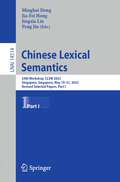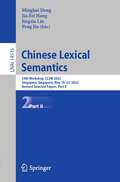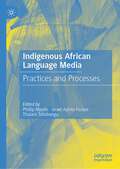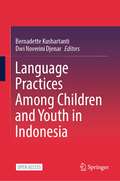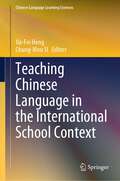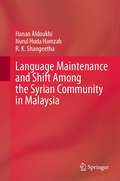- Table View
- List View
Chinese Lexical Semantics: 18th Workshop, Clsw 2017, Leshan, China, May 18-20, 2017, Revised Selected Papers (Lecture Notes In Computer Science Ser. #10709)
by Minghui Dong Jia-Fei Hong Jingxia Lin Peng JinChinese Lexical Semantics: 18th Workshop, Clsw 2017, Leshan, China, May 18-20, 2017, Revised Selected Papers (Lecture Notes In Computer Science Ser. #10709)
by Minghui Dong Jia-Fei Hong Jingxia Lin Peng JinIndigenous African Language Media: Practices and Processes
by Phillip Mpofu Israel Ayinla Fadipe Thulani TshabanguThe book contributes to the sparse academic literature on African and minority language media research. It serves as a compendium of experiences, activities and case studies on the use of native language media. Chapters in this book make theoretical, methodical and empirical contributions about indigenous African language media that are affected by structural factors of politics, technology, culture and economy and how they are creatively produced and appropriated by their audiences across African cultures and contexts. This book explores indigenous African language media about media representations, media texts and contents, practice-based activities, audience reception and participation, television, popular culture and cinema, peace and conflict resolution, health and environmental crisis communication, citizen journalism, ethnic and identity formation, beat analysis and investigative journalism, and corporate communication. There are hardly any similar works that focus on the various issues relating to this body of knowledge. The book provides a valuable companion for scholars in various fields like communication, media studies, African studies, African languages, popular culture, journalism, health and environmental communication.
Language Practices Among Children and Youth in Indonesia
by Bernadette Kushartanti Dwi Noverini DjenarThis open access book presents studies of language use in Indonesia, focusing on children and youth. It reports on developments in the use of language for narrative production and within the realm of popular culture and traditional cultural practices in Indonesia. Through studies that include cohesion in narrative production, language in radio advertising, naming practices and formulaic prohibitions in Javanese, and speech presentation in popular fiction, the book provides insights into how sociocultural changes are reflected in language. This book is a useful resource for students and scholars conducting research on language and cultural practices in Indonesia, particularly in relation to children and young people.
Teaching Chinese Language in the International School Context (Chinese Language Learning Sciences)
by Jia-Fei Hong Chung-Mou SiThis book explores the learning and teaching of K-12 Chinese language in international schools. The authors of this book are scholars from teaching training institutions and universities, as well as professional frontline teachers. With a combination of the works and insights from both perspectives of theory and practice, the book presents how theories of teaching can be operated in classroom to improve the effectiveness of language teaching. It covers curriculum setting, design of teaching materials, teaching principles, methods, strategies, and evaluation. The book also discusses issues and concepts such as concept-driven learning, identity change and recognition of L1 and L2 Chinese teacher, pinyin teaching, Chinese character teaching, evaluation for learning improvement, and integration of South Asian non-Chinese speaking students into local schools. It emphasizes empirical action research methods. This is a highly informative and carefully presented book, providing high value insights to scholars from university and teacher training institutions and teachers from kindergartens, primary, and secondary schools around the world.
Language Maintenance and Shift Among the Syrian Community in Malaysia
by Hanan Aldoukhi Nurul Huda Hamzah R. K. ShangeethaThis book investigates language choices in different domains among Syrian Arab Muslim families who came to Malaysia after war broke out in their country. It focuses on how Syrian Heritage Language (HL), Modern Standard Arabic (MSA), Classical Arabic (CA), and other languages that might be spoken by these families were maintained and/or shifted from the time these families came to Malaysia until the lockdown due to the COVID-19 pandemic. Most works on Syrian community in Malaysia are focused on social and humanitarian issues; none has explored how Syrians in Malaysia are managing their language use in connection with day-to-day communication and integration. As the Syrian community in Malaysia adapts by learning the host language, their mother language/s might experience a shift. The way the minority communities view their mother language by prioritizing or deprioritizing its use in the family milieu are factors that contribute to language maintenance and language shift (LMLS). As such, this book provides insights on how Syrian parents are managing their own and their children’s language/s, along with the language of the host country.
